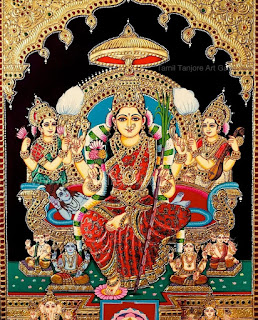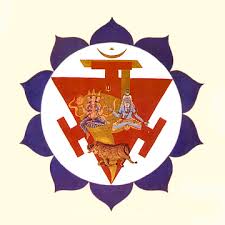The nāma-s from 249 to 340 discuss on the ‘Pañcha -Brahma svarūpa’ known as the five acts of the Brahman.
पञ्च-प्रेतासनासीना (249)
Pañcha-pretāsanāsīnā
She is sitting on a throne held by five corpses. These five corpses are Brahma, Viṣṇu, Rudra, Mahādeva and Sadāśiva. Brahma looks after creation, Viṣṇu looks after sustenance, Rudra causes death, Mahādeva conceals the dissolved universe (tirodhāna) and Sadāśiva again re-creates the universe (anugraha).
पञ्च-ब्रह्म-स्वरूपिणी (250)
Pañcha-brahma-svarūpiṇī
These two nāma-s explain the cosmic creation. The Brahman has five functions to perform. They are creation, sustenance, destruction, annihilation and salvation. The previous nāma underlined the importance of Lalitāmbikā in all acts of the Brahman and this nāma asserts that She is the Brahman.
चिन्मयी (251)
Chinmayī
She is in the form pure consciousness. Cin here means cit. Pure consciousness is that stage of awareness, where there is no differentiation between the known, the knower and the knowledge.
परमानन्दा (252)
Paramānandā
She is the embodiment of happiness
विज्ञानघन-रूपिणी (253)
Vijñānaghana-rūpiṇī
She is the essence of pure consciousness. Essence means the subtle form of consciousness. Ānanda or supreme happiness is the gross form of consciousness.
ध्यान-धातृ-ध्येय-रूपा (254)
विश्वरूपा (256)
Viśvarūpā
Viśvarūpā means omnipresent. When the mind ceases to think or when the mind disassociates from the sensory organs one reaches a stage where there's no happiness or sorrow. Only in this stage, Viśvarūpa is realized. She is the Viśvarūpa, the omnipresent.
जागरिणी (257)
Jāgariṇī
The three stages viz. awake, dream and deep sleep are now being discussed from this nāma till 263.
She is in the form of waking state in the living beings.
स्वपन्ती (258)
Svapantī
She exists in dream state too.
तैजसात्मिका (259)
Taijasātmikā
The individual soul associated with the dream state discussed in the previous nāma is called taijasa. Taijasa is the word derived from tejomaya , which means splendour or light, shining, brilliant. She manifests in this stage.
सुप्ता (260)
Suptā
The third of the three known stages is called ‘suṣupti’, the state of deep sleep or the state of unconsciousness. In the stage of deep sleep, one is not aware of anything around him. In this state mind also rests. She is present in this stage as well, the confirmation of Her omnipresence.
प्राज्ञात्मिका (261)
Prājñātmikā
She is known as prājñātmikā in the suṣupti stage.
तुर्या (262)
Turyā
This is the fourth stage of consciousness. It cannot be experienced automatically. This stage can be attained only through meditation. She exists in the form of turiya stage.
सर्वावस्था-विवर्जिता (263)
Sarvāvasthā-vivarjitā
Previous nāma-s confirmed Her existence in all the four stages. Now it is said that She is beyond these stages, again the quality of the Brahman. She exists in this stage too.






No comments:
Post a Comment